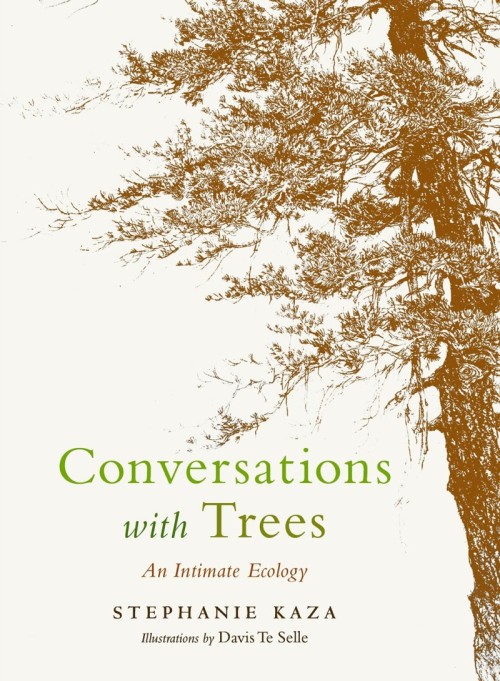
| Amazon
by Stephanie Kaza, illustrations by Davis Te Selle
Shambhala, 2019
The view – sacrosanct in many indigenous cultures – that the natural, material world is animate not inert, has long been considered as heresy by conventional Euro-American theologians and scientists. But in our time, thousands of researchers are investigating complex interrelationships among humans and other-than-human “beings.”
By 1993, when Stephanie Kaza first published a collection of essays entitled The Attendant Heart: Conversations with Trees, ideas about the sentience of animals and plants had moved from the mystical hinterlands to be seen as worthy of study by biologists and botanists. In recent years, German forester Peter Wohlleben’s book The Hidden Life of Trees has been an international bestseller, and David George Haskell’s The Forest Unseen has been a finalist for the Pulitzer Prize.
Probably every reader of this review, in childhood and later, has had moments of what Kaza calls intimacy with specific trees and with communities of trees, including responses that could readily be called love. And yet the idea that we can converse with trees will strike many of those same readers as fanciful.
Kaza doesn’t flinch from a skeptical response, and the new edition of her book repositions her earlier subtitle as the main title now: Conversations with Trees.
The manifold currents in Stephanie Kaza’s sensibility – as ecologist and Buddhist, teacher and wanderer, activist and contemplative – sometimes chafe but often combine. She acknowledges there can be tension in her efforts to find equilibrium with different species of intelligence. After describing a midsummer meadow “flamboyant with wildflowers,” she muses, “One part of my mind wants to identify each of these delightful beings scientifically by name; another wants only to gaze at their exquisite beauty. Two approaches to the marvelous complexity before me, two ways of rejoicing in form.”
She brings botanical, reverential, pedagogical, ethical, and lyrical responses to bear on her book’s premise, which she describes as “mutually respectful relations with trees,” and a “growing sense of moral obligation to forests and woodlands.” And along with a scientist’s painstaking inquiry, she embraces the Zen meditation known as shikantaza – just sitting – to spend time in silence in the company of trees.
While Kaza lived for many years in Vermont, the trees that are the focus of her essays are mainly out west. She also relates encounters while doing field research in the tropical forests of Costa Rica and Thailand.
Sometimes Kaza’s prose seems fulsome. She frequently uses present-tense narration, which can seem impressionistic and transient, more like a personal journal than a fully formed essay. Another quibble is the way Kaza sometimes attributes speech to trees: “The redwoods that live in my memory are saying, Come, come be with us today, touch us, sit with us, listen to us, stay for a while, let’s enjoy each other.”
Research documents that trees communicate in a multiplicity of ways, but attributing human language to trees diminishes their many essential distinctions instead of amplifying the intricacy and wondrous strangeness of their ways, so different from ours.
At one point Kaza is in the woods with a pair of children. She points out to them that smaller trees are growing in a circle where a giant redwood had formerly grown. “When it died long ago, it left a ring of new trees that sprouted around the base.” Then she explains that “A baby tree living off a big tree can survive much better than one grown from a seed. . . . Seeds have to find their own water, while a stump sprout can draw water from the parent’s roots.” Her teaching is exciting and precise, thrilling in the details, yet the passage ends abruptly, as she says, “But that’s enough biology for now. The children need a chance to talk directly with these trees.”
That’s a rhetorical turn, but why make adversaries of analysis and empathy? The science she suddenly set aside hadn’t sounded disembodied or academic, and the scene was dramatically grounded, offering what Kaza elsewhere calls the “adrenaline charge” that comes with learning.
The book shines when the author enters into a whole-hearted and mentally engaged concentration. Her extended rumination on a solitary bay laurel or “pepperwood” tree that may be eight hundred or a thousand years old is especially involving, as the ecologist in Kaza comes to the fore, reflecting on the eras of storms, fires, clearances for vineyards, devastation of the grapes by aphids, then an onslaught of cattle and sheep ranches.
Contemplation of a woodpile yields another of the book’s strongest pieces. Here Kaza wrestles with our reliance upon wood for so many products. She describes the contradictions she feels, harvesting firewood by chainsaw. Personal reflection ramifies into speculations about the ways fear can be seen in the Europeans’ leveling of forests, superimposing orderly row crops on “overgrown” wooded lands.
For the new edition of Conversations with Trees, illustrations have been added, and Davis Te Selle’s powerfully evocative lithographs deliver a visual and visceral counterpoint to Kaza’s prose. The reissue of Stephanie Kaza’s book at this time is urgently right.
We will live, in whatever ways we survive, not just in proximity to trees but as their companions in existence. The ability of forests to absorb proliferating carbon and replenish the planet’s oxygen will be crucial to successes we achieve in contending with disruptions in global climate.
On July 29, 2019, Ethiopians planted 353,633,660 tree seedlings in 12 hours. It’s not difficult to believe that many of those planters conversed with their trees as they placed them in the ground, wishing them health and long life.

